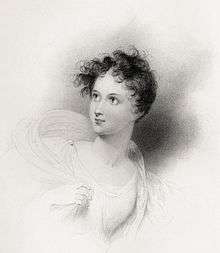Charlotte Bacon
Lady Charlotte Mary Bacon, née Harley (12 December 1801 – 9 May 1880), was the second daughter of Edward Harley, 5th Earl of Oxford and Earl Mortimer.[1] Her beauty as a child prompted Lord Byron to dedicate the first two cantos of Childe Harold's Pilgrimage to her, under the name "Ianthe".[2] Lord Byron had been one of the many lovers of her mother, Jane Elizabeth Scott. Lady Charlotte was also the subject of the painting Lady Charlotte Harley as Hebe by Richard Westall.
Lady Charlotte Bacon | |
|---|---|
 Lady Harley as Ianthe, to whom Lord Byron dedicated Childe Harold's Pilgrimage | |
| Born | Lady Charlotte Mary Harley December 12, 1801 |
| Died | May 9, 1880 (aged 78) |
| Occupation | English aristocrat |
| Spouse(s) | Anthony Bacon |
| Parent(s) | Edward Harley, 5th Earl of Oxford and Earl Mortimer Jane Elizabeth Scott |
[3] "In the period leading up to his marriage to Annabella Milbanke, early in 1815 [Byron]...was enjoying an affair with the coolly promiscuous, forty-year-old militant Whig Lady Oxford [Charlotte’s mother] in the course of which he sexually molested her eleven-year-old daughter, Lady Charlotte Harley, to whom, under the name of Ianthe, he dedicated the seventh printing of Childe Harold, with attendant high-flown verses.”[4]
She married Captain (later Major General) Anthony Bacon in 1823. They had three children. He died in 1864 and the three children all moved to South Australia.[5] She stayed with relatives in South Australia between 1865 and 1877, and Charlotte Waters, Northern Territory was named in her honour by R. R. Knuckey and G. R. McMinn in 1871. Her son Harley Bacon had contributed food supplies to Charles Todd's survey team.[6]
References
- Debrett, John; Collen, George William (1840). Debrett's Peerage of England, Scotland, and Ireland. revised, corrected and continued by G.W. Collen. London: William Pickering
- Gunn, John Alexander Wilson; Wiebe, Melvin George. eds. (2008). Benjamin Disraeli letters, Volume 7. University of Toronto Press, ISBN 9780802087287
- Byron: Child of Passion, Fool of Fame, Benita Eisler, Alfred A. Knopf, 1999.
- John Updike, “Mud and Flames,” a review of Eisler’s book, The New Yorker, August 22, 1999, page 85.
- Loyau, George E. (1885). Notable South Australians. Adelaide: George E. Loyau. p. 216 – via Wikisource. [scan

- "Still waters remember Ianthe". The Canberra Times. 67 (21, 081). Australian Capital Territory, Australia. 2 January 1993. p. 14. Retrieved 1 August 2016 – via National Library of Australia.
External links